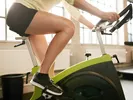By continuing to use this site, you agree to our use of cookies.
How to Move Exercise Equipment
Jan 10, 2025
Moving a home gym
When you’ve invested in home gym equipment for your health, you’ll want to keep it safe during a long-distance move.
Luckily, if you gather the right materials and pack carefully, you can keep your fitness equipment in great shape for the new place.

Materials needed for moving fitness equipment
Here’s what you’ll need on hand to pack and move a home gym:
- 1-2 helpers (friends or professional movers)
- A dolly or hand truck
- All-purpose cleaner and rags or paper towels
- Basic toolkit
- Equipment manuals
- Moving blankets
- Packing paper or Bubble Wrap®
- Packing tape
- Permanent marker
- Plastic stretch wrap
- Straps or heavy-duty rope
- Sturdy cardboard boxes
- Zip-top bags
Moving weights and lifting racks
Weightlifting power racks, squat racks and their accompanying weights are often the heaviest equipment in a home gym. Moving and packing these items requires care to avoid injury or property damage.
Remove weights from racks, clean them with an all-purpose cleaner and set them aside. Clean the empty rack and refer to the manual for instructions on disassembling it. If you don’t have the manual, look for one on the manufacturer’s website.
Wrap the rack pieces in moving blankets and secure them with plastic stretch wrap and packing tape. Pack weights in separate sturdy boxes, avoiding making them too heavy. Line boxes with crushed packing paper or Bubble Wrap® and fill any gaps to avoid shifting. Reinforce the boxes with straps or heavy-duty rope and label “Heavy.”
Get help loading or unloading and use a hand truck or dolly. Distribute the weight evenly within the moving equipment and tie down the packages.
How to move a treadmill
Start by cleaning the equipment. Then, place any removable parts (safety switch, power cord, etc.) into zip-top bags before packing them into boxes.
If the treadmill is not foldable, consult the manual for disassembly instructions to make it easier to manage. After folding or taking apart the treadmill, wrap the pieces in moving blankets and secure them with plastic stretch wrap and packing tape.
High-end treadmills can weigh up to 400 pounds, so they’re not something you want to move on your own. Grab a helper and a hand truck or dolly for loading. Make sure to tie down the treadmill inside the moving equipment to avoid shifting during transit.
Moving an elliptical machine or stationary bike
Transport can damage ellipticals, resistance machines, rowing machines, stair-climbing machines and stationary bikes if the movable parts are not secured properly. The best way to move this equipment is to take it apart. Follow the manufacturer’s instructions and pack it in its original packaging or another large box.
To move assembled equipment, protect it by following these steps. First, clean it with an all-purpose cleaner. Next, place easily removable parts like screens, handles, pedals or power cords in zip-top bags before packing them in boxes. Lock down any moving parts and wrap the equipment in moving blankets secured by plastic stretch wrap and packing tape.
As with all heavy equipment, get a helper to load it and use a hand truck or dolly. Tie down the equipment inside the moving container or trailer to avoid shifting during transit.
Packing sports equipment and smaller items
Follow household goods packing tips for smaller items and sports equipment in your home gym. Use sturdy cardboard boxes and label each one according to the contents. Avoid making any packages too heavy and protect fragile items with packing paper or Bubble Wrap®.
Place things like jump ropes or resistance bands in individual zip-top bags before packing them inside boxes. Deflate exercise balls before packing to avoid damage.
Roll yoga mats tightly to save space and pack them upright in tall boxes. You can put foam blocks, balls and other soft accessories like towels in the same package.
Ready to move your gym (and everything else)?
Choosing the right mover for the job is one of the most important aspects of any long-distance move. That’s where U-Pack® comes in. We’re a DIY moving service with over 25 years of experience in long-distance moves.
Call 844-362-5303844-594-3077 or use our free online form to get your free moving quote today. Let us know in the comments if you have any questions about packing home gym equipment or how U-Pack works. We’re happy to help!
More articles you might like...



